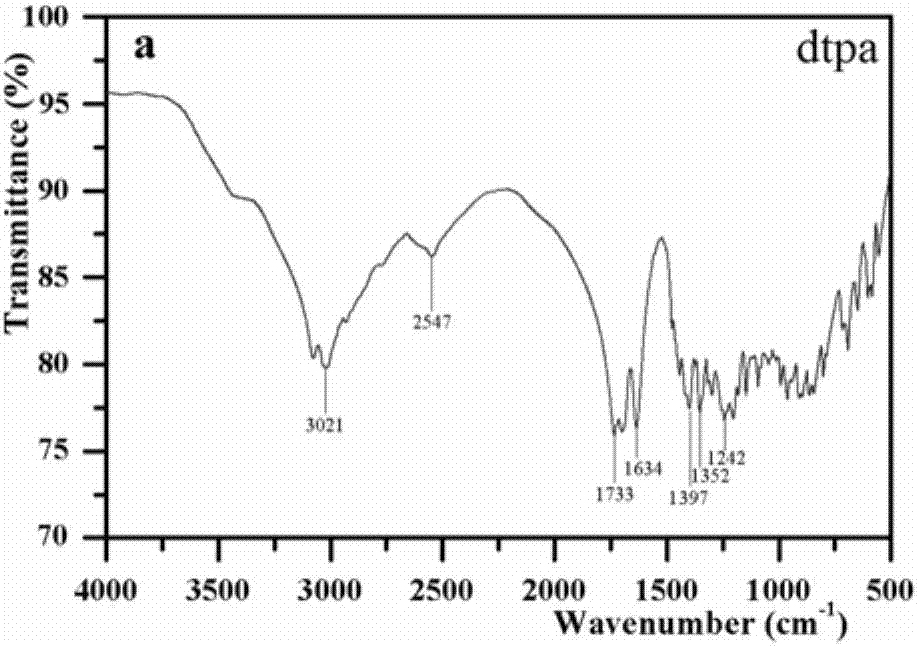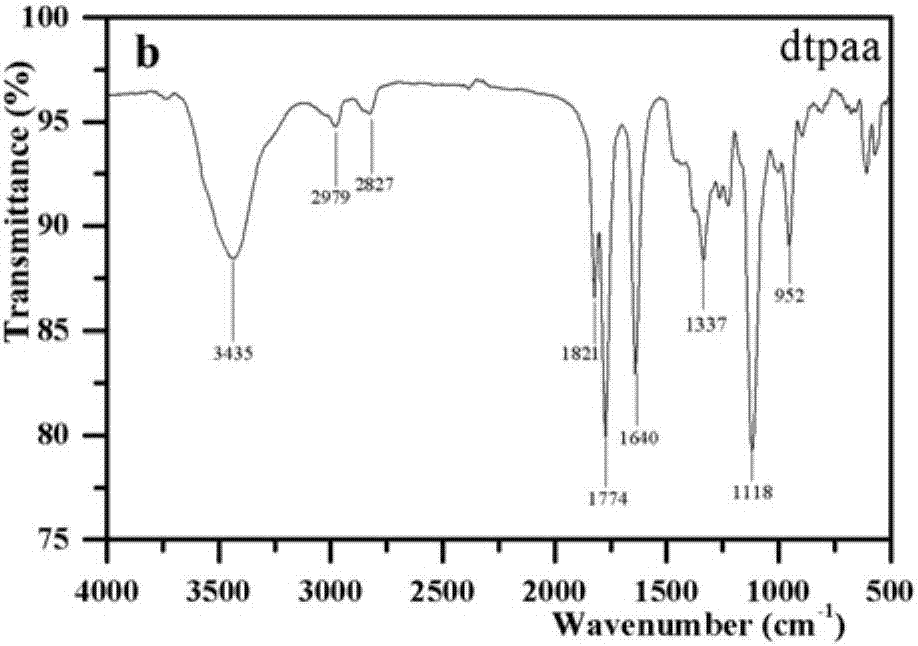Novel fluorescent probe as well as preparation method and application thereof in detecting uric acid
A fluorescent probe, a new type of technology, applied in the field of analytical chemistry, can solve problems such as the death of pregnant women, and achieve the effect of low cost
- Summary
- Abstract
- Description
- Claims
- Application Information
AI Technical Summary
Problems solved by technology
Method used
Image
Examples
Embodiment 1
[0028] Embodiment 1 novel fluorescent probe Tb III -dtpa-bis(2,6-Diaminopurine)
[0029] (1) Preparation method
[0030] 1, the preparation of diethylenetriaminepentaacetic dianhydride (dtpaa)
[0031] Weigh 7.8100g (0.02mmol) of dtpa, 16.0mL (0.08mmol) of acetic anhydride, and 10.0mL (0.12mmol) of pyridine into a three-necked round bottom flask, mix well, and heat with stirring at 65°C for 24h. Cool to room temperature, filter the reaction mixture, wash twice with a small amount of acetic anhydride and anhydrous ether, filter with a vacuum pump, and dry the resultant in a vacuum oven at 80°C to obtain dtpaa.
[0032] 2. Preparation of diethylenetriaminepentaacetic acid bis-2,6-diaminopurine (dtpa-bis(2,6-Diaminopurine))
[0033] Take 1.9610g of dtpaa (5.5mmol), 8.0mL (16.5mmol) of triethylamine, anhydrous DMF (50mL), and 1.6515g (11mmol) of 2,6-diaminopurine in a three-necked round bottom flask, and mix well. Heating at a constant temperature of 100°C and stirring rapidly...
Embodiment 2
[0039] Embodiment 2 fluorescent probe Tb III Application of -dtpa-bis(2,6-Diaminopurine) in detection of uric acid
[0040] 1. Fluorescence spectrum of fluorescent probe for detection of uric acid
[0041] Experimental conditions: Take a certain amount of uric acid (UV) and prepare it with Tris-HCl buffer solution with pH=7.4 to a concentration of 5.0×10 -4 mol / L solution as a uric acid stock solution.
[0042] Take 5.0 mL of uric acid stock solution in a 50 mL volumetric flask, add 5.0 mL of fluorescent probe stock solution prepared in Example 1, and use Tris-HCl buffer solution with pH=7.4 to make up volume. At this time, the concentration of the probe and each detection substance is 5.0×10 -5 mol / L. Changes in the fluorescence spectrum were observed at an excitation wavelength of 241 nm.
[0043] The result is as Figure 4a , Figure 4b shown. Such as Figure 4a As shown, under the excitation of 241nm, the fluorescent probe has a strong emission peak at 350nm. Uri...
PUM
 Login to View More
Login to View More Abstract
Description
Claims
Application Information
 Login to View More
Login to View More - R&D
- Intellectual Property
- Life Sciences
- Materials
- Tech Scout
- Unparalleled Data Quality
- Higher Quality Content
- 60% Fewer Hallucinations
Browse by: Latest US Patents, China's latest patents, Technical Efficacy Thesaurus, Application Domain, Technology Topic, Popular Technical Reports.
© 2025 PatSnap. All rights reserved.Legal|Privacy policy|Modern Slavery Act Transparency Statement|Sitemap|About US| Contact US: help@patsnap.com



